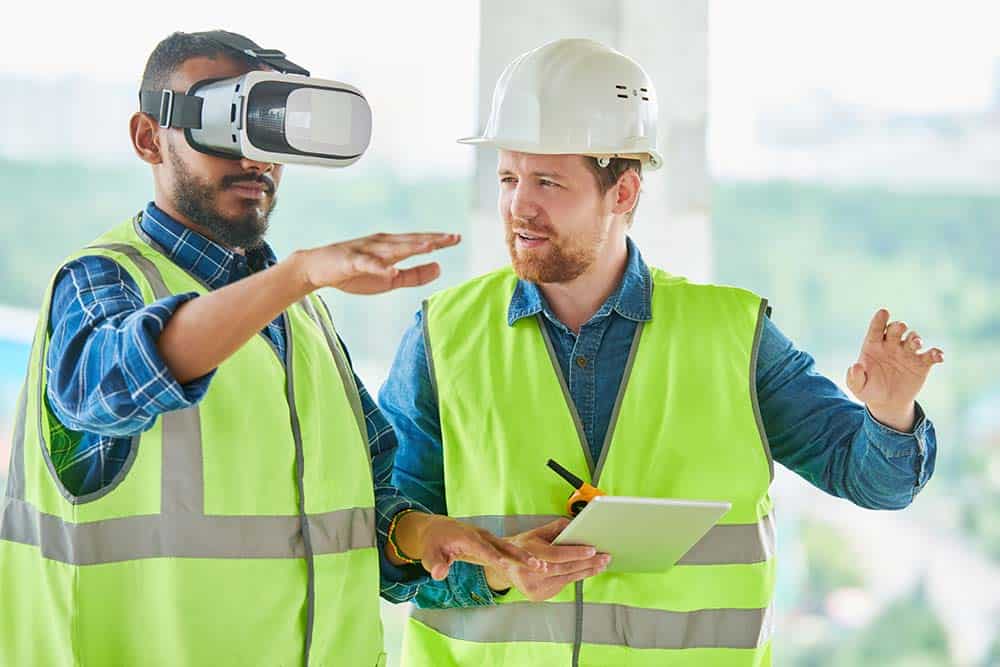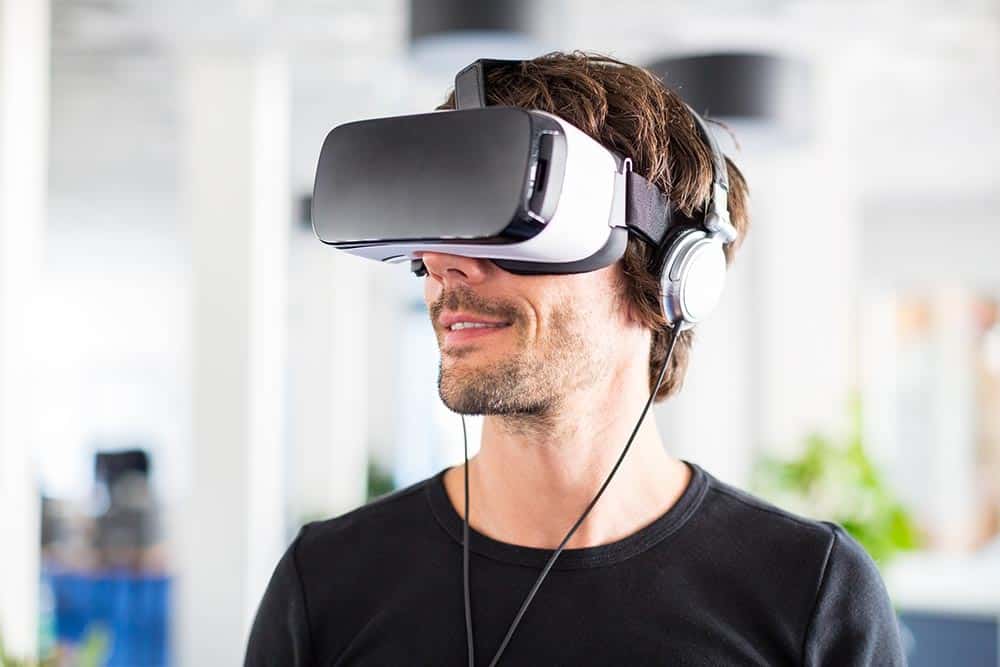Today, VR technology is still in the starting pit and is still best known for its application in gaming experiences. But VR also opens up new opportunities for education and teaching.
The use of VR glasses can make training both more real-life and engaging. In addition, VR technology allows you to perform training faster, with higher professional quality and with higher security. In this blog post, we highlight five players from different sectors who believe that VR technology will revolutionize training.
These five have already used VR in training and see various benefits of this. Furthermore, we look at VR research and the criticism and limitations associated with VR in the educational context.
What is VR?
Virtual Reality, also known as VR, involves replacing as many sensory impressions as possible through virtual/digital impressions. This is done with the help of VR glasses that place you into an artificial world created with digital content consisting of images, audio, video and games.
Fire training with VR technology
Securitas has, in collaboration with Real training, developed fire training with VR technology, especially for companies that train their employees in how to prevent and extinguish fire.
The training consists of a combination of e-learning and practical exercises with VR glasses that are useful as experience for the day one is in a real situation.
Business developer in fire and rescue, Ole-Ivar Bjørkamo, says that VR technology saves the employer time and money, and that learning is better. VR technology makes it easier to train more frequently than before, and also gives you the opportunity to do hands-off training on a large number of people in less time than traditional firefighter training.
Another advantage of VR training is that you save the environment by bringing the exercise into the technological world. The exercise is far more environmentally friendly and has higher safety than regular, practical training with physical fire.
Experienced firefighters refer to fire training with virtual reality as one of the most realistic training they have ever experienced. In the virtual world, one can practice extinguishing fires in situations that are more real-life based, rather than practicing extinguishing a fire in a fire barrel in a courtyard.
Take a look at this video to see what fire training with VR is all about:
VR in safety training
The reduced risk VR technology brings has made it relevant in other forms of safety training as well.
The international competence company Trainor started in 2017 to develop VR technology that simulates risky construction projects. They have built their own VR studio to research how this technology can be targeted at users with special training needs.
With the support of Innovation Norway, the company has, among other things, developed Electri City, a virtual world developed for training in electrical safety.

Here is a scenario taken from ElectriCity. Photo: Trainor AS
The 3D world contains a number of different environments where you can create realistic scenarios and, with the help of VR, perform practical exercises for risky work in a safe environment.
Using advanced gaming technology, the practical training moves from a laptop with a mouse and keyboard and into a 3D world of its own. Here, you get a completely different presence and you can simulate the dangerous tasks that you perform in your daily work – without any risk.
Kåre Vegar Sund, creative director at Trainor, says that most people find using VR a fun experience, but emphasizes that it is first and foremost the learning effect and practicality you are interested in when bringing VR into training.
Although Trainor does not plan to offer full training courses in VR, they see the benefit of being able to perform crowd training on risky missions in a virtual world. Not only does it have high learning efficacy and practical utility, but is also safer and cheaper.
Virtual reality in education for the maritime sector
With VR glasses you can sit in a classroom on land, while you are on a platform far at sea at the same time. This can definitely be taken advantage of when training seafarers.
At the start of 2017, the University of Southeastern Norway received 13 million NOK from the Research Council to find out how VR glasses and virtual reality can be used as part of the education for the maritime sector.
– We are confident that the right use of the new reality technology will enable better, more efficient and significantly cheaper training of maritime personnel, said Associate Professor Salman Nazir at the Institute of Maritime Operations at USN to research.no at the launch of the research project.
Nazir believes that artificial reality will be the obvious preferred choice for training and education in a variety of sectors within five to ten years. He thinks there are four reasons for this:
- The technology enables training for a fraction of the cost of establishing and operating a large simulator park
- With VR glasses, you can experience and train in difficult situations anywhere, anytime
- The training allows for a higher degree of individual adaptation, which can make the training more interesting and relevant
- VR glasses can make training more realistic and intuitive, making it easier for users to understand what to learn
Research leader Stig-Einar Wiggen believes that VR glasses can be used as a supplement to the large simulators currently used for training. Namely, with more easy-to-use solutions, you will be able to train anywhere and anytime, thus improving the learning outcomes of maritime personnel in training.
Use of VR in primary school
VR is not only suitable for adult education and training. In fact, there are already several examples of VR use in primary school. Here are two of them.
VR technology in mathematics education
In the spring of 2017, Innit launched an exciting pilot project with Making View and Kommuneforlaget. The project is about using VR technology in connection with mathematics education in primary school, and has been named VR Education.
The goals of the project are to demonstrate that VR can engage students in a whole new way and thus, stimulate learning outcomes, as well as provide teachers with valuable data and statistics on the level and progression of each student in real time and over time.
The VR application that students use is designed as a game where students can choose to solve math tasks in two typical store scenarios. Teachers can monitor the results in real time as students complete the tasks, so they can be proactive in relation to students who need extra follow-up time. The teacher also has the ability to control the difficulty level for each student.
Read more about the tasks the students solve with VR glasses here.
Also read: Gamification in Training.
Today VR Education is being tested at several schools and the feedback is purely positive. Here is a snippet from when VR was tested at Innbygda School:
Language and writing training with VR
One of the main reasons that VR technology has not yet found its way into many training programs is the fear of cost and implementation. However, using VR doesn’t have to be complicated and expensive.
Groruddalen school is a good example of this. They have used VR glasses to vary and organize their teaching, and have chosen to use simple and affordable VR glasses in cardboard that are used in combination with a smartphone and a downloadable VR app.
The effects are many. The VR glasses not only create motivation and variety in the teaching, but can also be an important visual support and a concrete tool. This makes VR a good starting point for language and concept training. At Groruddalen school they have experienced that the use of VR increases text production and leads to a richer language and vocabulary for the students who struggle with writing.
Thus, VR opens up exciting educational and special education opportunities for variation, visualization, concretisation and language and communication training. Therefore, with cardboard VR glasses, the entrance fee is low.
Here you can see the students at Groruddalen school wearing VR glasses:
VR research and a critical look at VR
We have now seen that VR is making its way into training, and that those who do this have clear notions of how VR can have an impact on training in their industry – whether it be lower costs, higher efficiency or increased learning outcomes.
But what exactly does the research say about the use of VR in education?
At Viritual Reality Lab at the University of Copenhagen’s Department of Psychology, researchers measure the learning outcomes of various VR simulations. The goal is to break the code on how content should be posted, so that students learn something and are motivated by VR.
Guido Makransky, associate professor at the University of Copenhagen and manager of Virtual Reality, emphasizes that technology should not be used without a purpose. VR is not a miracle and does not provide anything in itself.
– But in some cases VR simulation can provide something extra. We test it as a supplement to regular teaching.
Tests from Makransky’s laboratory have shown the following:
- VR simulation works best as a repetition.The students in the experiment got the best results when they first heard a teacher talk about the topic (cells) and then witnessed a simulation.
- VR can be used to engage students in a topic.The researchers have seen, among other things, that VR can stimulate students’ interest in science.
VR – best suited for theoretical or practical knowledge?
The researchers at the Danish laboratory have also tested VR simulation that introduces engineering students to the safety rules in a virtual laboratory. The students were divided into three groups: those who received information through VR glasses, those who received the same information by reading a book and a recent group who obtained the information via a computer.
One week after the training, the students entered a real laboratory and demonstrated what they had learned. The task was to find errors in the laboratory that could create safety problems.
The group that had received the safety instructions through a book was the lowest-performing group. It turned out to be no difference between the computer and VR groups. However, the VR group performed much better than the other groups when tested in response to getting acid in their eyes.
Thus, it may seem that VR is not a good tool for learning facts, but that it is a good tool for learning practical knowledge.
Makransky also emphasizes that one must take into account that the effects observed today may be due to the technology still being new and exciting for many. However, even though the effect may become obsolete in the long run, he believes that it should be taken advantage of as long as it is in effect.
The possibilities in VR are too many and good to overlook
Thus, it may look like VR can increase learning outcomes if used for hands-on training, repetition and volume training. VR technology works best as a supplement to regular teaching.
We also see from our examples that VR technology can have a number of other positive effects for the education industry. Among these, we find the opportunity to train for risky work in a safe environment, increased efficiency, both in terms of being able to train more in less time and making it easier to train more frequently, a higher degree of individual adaptation and more realistic and intuitive training. In addition, VR technology can provide important visual support and function well as a concrete tool and as a source of interest for various topics.
With this in mind, it is almost impossible to envision a future education industry that does not take advantage of the opportunities that VR technology brings. Unless VR changes the way we conduct training in total, VR technology will definitely affect the way we learn in the future.
Did you like this article? Don’t forget to share it:
Sources:
Anne Ringgaard, «Lærere må vite hva teknologi bidrar med og hvordan», 13.05.18
Securitas, «Branntrening med VR-teknologi», 05.03.17
Stian Martinsen, «Slik lager vi e-læringskurs», 08.02.2016
Frode Aga, «Vil flytte risikofylt HMS-opplæring inn i VR-studio», 04.07.17
Kåre Vegar Sund, «Mener VR kan revolusjonere praktisk opplæring», 04.07.17
Magnus Skatvedt Iversen og Fredrik Laland Ekeli, «Vil bruke VR-teknologi til opplæring av sjøfolk», 11.01.17
Forskning.no, «Utvikler VR-teknologi til opplæring av sjøfolk», 26.01.17
Sveinung Wiig Andersen, «Når klasserommet blir virtuelt», 02.12.16
Statped, «Virtuell virkelighet»
Simen Mørch, «VR Education», 12.05.17
VR Eucation, «Use VR in education», 2019
Get more time for the important tasks
FrontCore’s training management system save you hours of time-consuming administrative work each month.

Author: Eline Hagene
Inbound Marketing Manager
Eline produces content to help training providers achieve a more efficient and profitable training day. She is certified in the Inbound methodology through Hubspot and has completed a Bachelor of Marketing management at BI Norwegian School of Management. Visit Eline’s LinkedIn profile here.







0 Comments